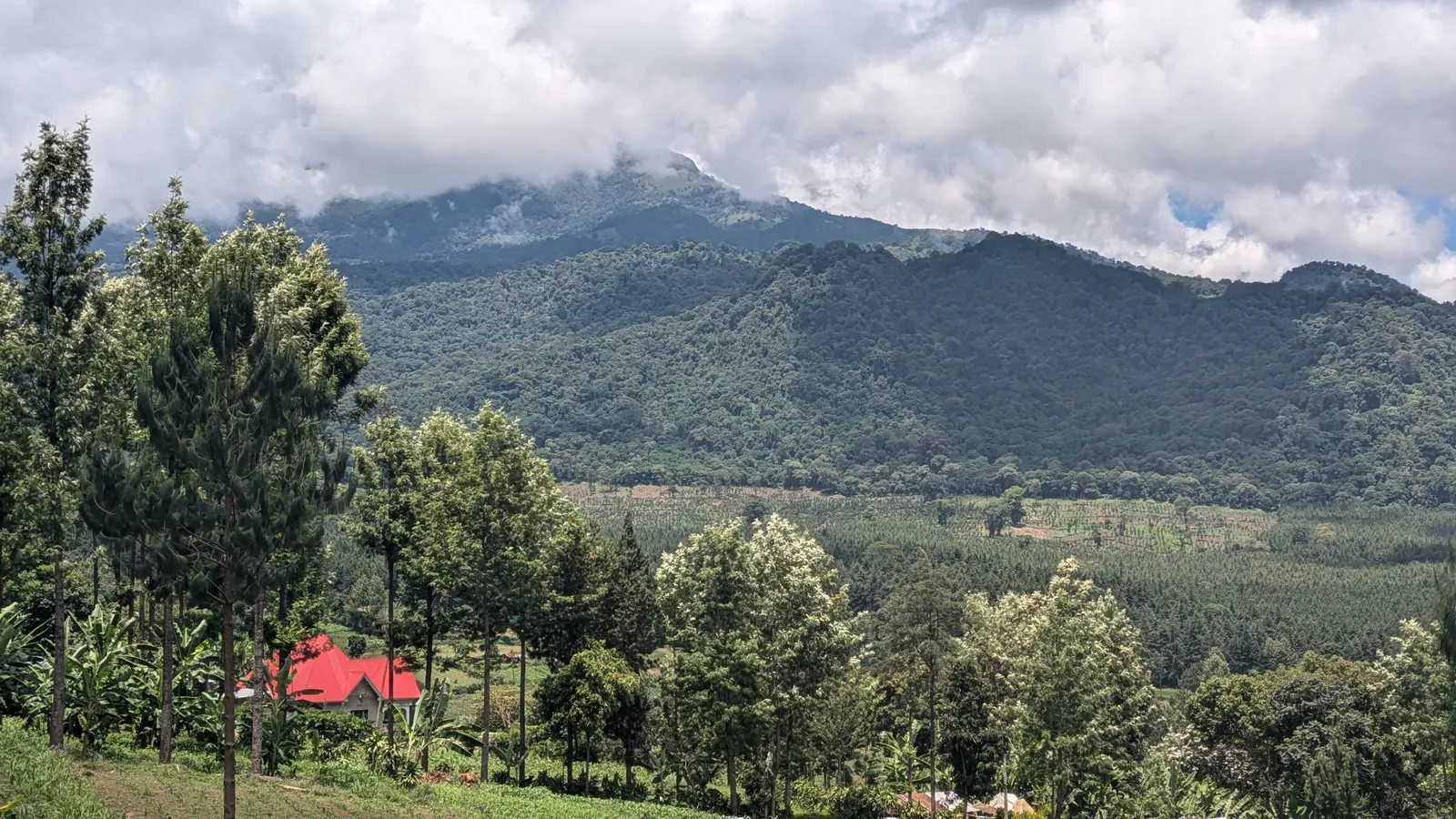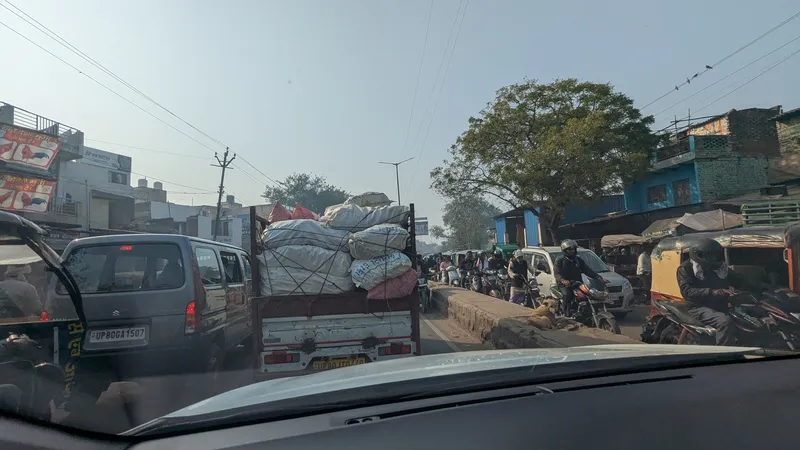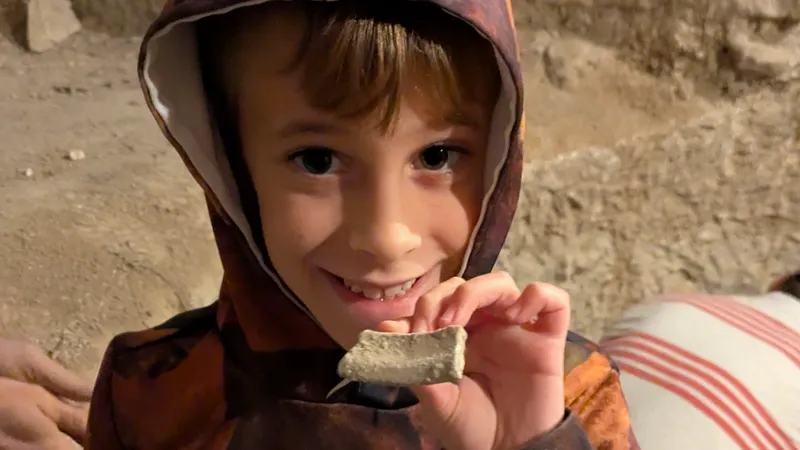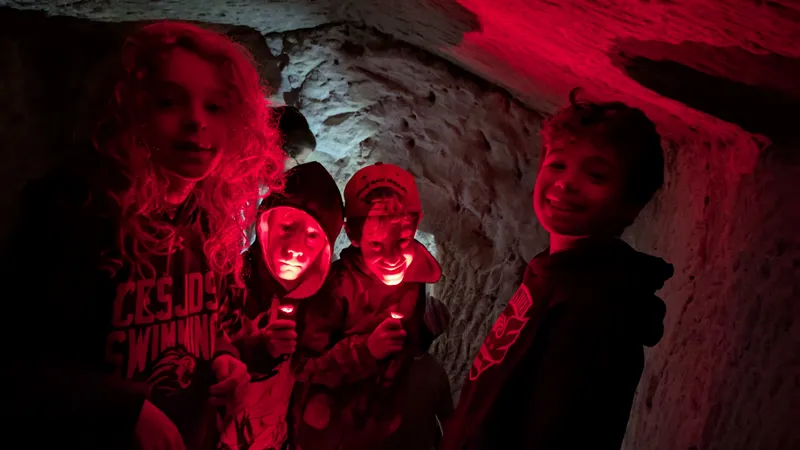Reflections regarding Friday November 1, 2024 in Arusha, Tanzania
Part of our goal for this world traveling adventure is to expose our children to different cultures and to learn from people around the world without lording our western sensibilities over others. I was very excited for our visit to the Mulala Village for Agape Women just for this reason.
Mulala Village for Agape Women is a small co-op set inside of Mount Meru. To get there we had to drive an hour to pick up Charlie, the local tour guide who knew which roads into the village were open after heavy rain and which were closed. He was kind and quickly gained the boys’ respect and genuine interest. As we drove up through the mountains, the terrain changed from dry and arid to lush and green. Banana, mango, and avocado trees were everywhere.
The co-op was a two story building set behind a gate. There was a cow and a goat grazing off to the side in a small, thatched shed. We were immediately invited upstairs to the rooftop for a traditional Tanzanian snack of coffee and African sweet potatoes. I don’t drink coffee and opted for tea while everyone else tried the coffee – well, the boys really had milk with a little coffee mixed in. From the roof we could see Mount Meru and its surrounding forests, and, when the clouds cleared, Mount Kilimanjaro. The village was in Mount Meru’s valley, which is why it was so lush and green.
Mama Ana, the founder of the co-op, and her daughter-in-law Gladness, joined us to tell her story. Mama Ana appeared to be around seventy and looked like she had lived a life with plenty of hardships. Her smile, however, was bright and ran from ear to ear. Mama Ana spoke in Swahili so that we could appreciate her language while Gladness translated for us. As we listened to Mama Ana’s story they began passing around an essay she wrote, “How [a] cow built [a] school” and information about Heifer International, a non-profit organization dedicated to donating cows, sheep, and goats to impoverished women to help establish a method for self-sustenance and long-term entrepreneurship opportunities. As it happened, the week before we left on our adventure in July as Amichai and were exiting a Trader Joes, we came across Heifer International representatives asking for donations. Amichai, who has a very large heart and is always eager to donate our money – and sometimes his – begged me to give money to the organization. When I hesitated, he reminded me how we are always teaching the boys about the importance of tzedakah/charity. How could I say no? We decided to donate enough money for Heifer International to gift someone a goat.
As soon as Amichai and I saw the pamphlet about Heifer International we got excited and told Gladness we knew about Heifer International. She stopped Mama Ana to hear our story and tell Mama Ana what happened. When Mama Ana heard that we had donated she smiled from ear to ear and said we were helping someone just like her. Amichai looked like he had just won a million bucks. I was relieved to know the organization we donated to really was making a difference. It is one thing to donate to an organization and assume it is doing what it claims to do. It is another to see the outcome in person. Because of the cow Mama Ana had received thirty years ago, she was able to start a milk business, which grew into a cheese making business. Mama Ana is a model of how to take a gift and lift others up with it. Instead of keeping all of the profits for herself she brought other women into the business, literally changing the economic situation for numerous families. With the profits they were able to buy the bricks that the Tanzania government was unable (or possibly unwilling) to purchase to build not one, but two schools for the village children who up until the schools were built were not attending school. Once the schools were built, the Tanzanian government provided the teachers and curriculum. Mama Ana finished her story with the song Jambo Bwana and we were invited downstairs for a walk around the village with Charles and Gladness as tour guides.
The village grows carrots, bananas, maize, beans, coffee, and tea. The boys recalled their time in London searching for wild raspberries and asked if there were any here. Luckily for them, there were. Charles led the search for wild raspberries, which were absolutely delicious. He also made balancing hats from ferns. These hats are used to help individuals carry baskets on their heads. Amichai and Eitan could not get enough of the hats and kept trying to balance items on their heads. We learned that our hair is too soft to keep a balancing hat on without it sliding off. This drew a lot of laughs from Charles and Gladness. As we walked we learned about the Forgiveness Plant and the importance of hierarchy. Whenever there is a fight or argument between two people in the village, no matter who was in the right, the younger of the two brings a Forgiveness Plant to the elder as a sign of respect and to end the dispute. The plant is also used by the community elders to establish property borders. The village is small and yet somehow still had three different churches with several different Christian denominations represented all within a fifty to one-hundred feet of each other. As the boys played with their balancing hats, Gladness and I bonded over motherhood and talked about her dream to open a restaurant in the city nearby. She is also trying to learn as much as possible from Mama Ana because she will be taking over the co-op one day and hopes to keep it going for many years to come.
Back at Mama Ana’s house, learned more about the other farming techniques they used to provide goods for the market. One of the coolest experiences was when Charles opened a beehive in a wooden log. As soon as he opened it Gladness poured a little flour into it to keep the bees from getting stuck in the honey that oozed out. This hive looked like no other hive I have seen before. Instead of a honeycomb structure, the hive was made up of a collection of bulbs. The bees are stingless bees that look more like tiny flies. Charles taught us that these bees are harmless to humans, but devastating to stinging bees. When a stinging bee tries to enter a stingless bee’s hive the stingless bees attack it so ferociously that it has no chance and is devoured. Looking at the bees it was hard to believe, but we took Charles’s word for it. He also taught us that these bees are extremely busy and keep their hive very clean. There are bees for every job, and they get to work as soon as a problem begins. Some are responsible for gluing the wood shut, others for rebuilding the hive, and still others for cleaning the hive. At the end of our lesson, Charles gently tapped a bulb open and let honey drip onto a small spoon. The honey tasted just like Israeli grape juice. I loved it. It is much better than most other honey I’ve tasted.
After, we were taught how to churn butter that Tanzanian way, which included a lot of singing of Jambo Bwana and churning to the beat of the music. Each of us took a turn churning, but all were impressed by Charles who is clearly a master churner. According to Gladness “a strong man like Charles” can churn butter in one hour while the rest of us would take four to five hours. Next, we learned about coffee making. After learning how to recognize a coffee tree, we picked the berries and put them in the sun to dry. A separate batch was ready for pounding to remove the husks. The pounding is done with a tall wooden mortar and a long pestle. So long that it takes two people working together to pound the berries and remove the husks. We, of course, did just that while singing Jambo Bwana. Mama Ana was having a hoot of a time laughing at us work out of rhythm. Admittedly, it was pretty hilarious. As two of us would work, Mama Ana and her colleagues would dance around us. At one point she gave Shai a piggyback ride! All I could think was how much I hoped I would be able to give kids a piggyback ride when I am her age.
After separating the shells, we used a traditional sieve to separate the beans for roasting. As Charles roasted the beans on an open fire, a few women made more balancing hats. With the hats we tried balancing a banana bunch. It took a few tries to get the balancing hat to stay on my head, but eventually I was able to balance a banana bunch on my head for a solid fifteen seconds. We gave the women a great laugh. When the roasted beans were ready we used the same pestle and mortar to grind the beans into coffee grounds, all while singing Jambo Bwana. I finally asked why they sing that song so much. Mama Ana explained it is to help pass the time and make the work more enjoyable. Each time they sing it they change the words based on the work that is being done.
When the grounds were ready, they mixed them with boiled water for coffee. Usually we do not allow the boys to have coffee because there is way too much caffeine in it and our boys have an exceptional amount of energy already. But, how could we say no after all of that hard and fun work we just did? I even joined in to taste the fruits of our labor. Although I am still not a fan of coffee, I could understand how someone might enjoy a cup after tasting the fresh Arabica coffee we made. Amichai thought the coffee was divine. As we sipped our coffee, Chaim explained how the higher elevation the coffee trees are, the better the coffee they produce. This made everyone want to know how high we were so Hosea did a quick search on his phone. We were about 1500 feet high. Lastly, we had a quick lesson on how they make cheese. More interesting to us than the cheese was realizing that the rennet used says “free of swine products” and had what looked like a kosher certification but for Muslims.
We could have stayed at the village for so much longer, but Shabbat was calling. As we said our goodbyes, I was overcome by the stories of resilience and persistence we had heard and what seemed like authentic joy that we had witnessed.



